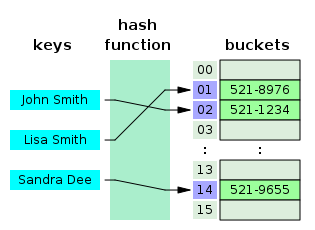
Back جدول تلبيد Arabic Хеш таблица Bulgarian Hash tabela BS Taula hash Catalan Hašovací tabulka Czech Hashtabel Danish Hashtabelle German Πίνακας κατακερματισμού Greek Hakettabelo Esperanto Tabla hash Spanish
| Hash table | ||||||||||||||||||||||||
|---|---|---|---|---|---|---|---|---|---|---|---|---|---|---|---|---|---|---|---|---|---|---|---|---|
| Type | Unordered associative array | |||||||||||||||||||||||
| Invented | 1953 | |||||||||||||||||||||||
| ||||||||||||||||||||||||

In computer science, a hash table is a data structure that implements an associative array, also called a dictionary or simply map; an associative array is an abstract data type that maps keys to values.[3] A hash table uses a hash function to compute an index, also called a hash code, into an array of buckets or slots, from which the desired value can be found. During lookup, the key is hashed and the resulting hash indicates where the corresponding value is stored. A map implemented by a hash table is called a hash map.
Most hash table designs employ an imperfect hash function. Hash collisions, where the hash function generates the same index for more than one key, therefore typically must be accommodated in some way.
In a well-dimensioned hash table, the average time complexity for each lookup is independent of the number of elements stored in the table. Many hash table designs also allow arbitrary insertions and deletions of key–value pairs, at amortized constant average cost per operation.[4][5][6]
Hashing is an example of a space-time tradeoff. If memory is infinite, the entire key can be used directly as an index to locate its value with a single memory access. On the other hand, if infinite time is available, values can be stored without regard for their keys, and a binary search or linear search can be used to retrieve the element.[7]: 458
In many situations, hash tables turn out to be on average more efficient than search trees or any other table lookup structure. For this reason, they are widely used in many kinds of computer software, particularly for associative arrays, database indexing, caches, and sets.
- ^ Martin Farach-Colton; Andrew Krapivin; William Kuszmaul. Optimal Bounds for Open Addressing Without Reordering. 2024 IEEE 65th Annual Symposium on Foundations of Computer Science (FOCS). arXiv:2501.02305. doi:10.1109/FOCS61266.2024.00045.
- ^ Cormen, Thomas H.; Leiserson, Charles E.; Rivest, Ronald L.; Stein, Clifford (2009). Introduction to Algorithms (3rd ed.). Massachusetts Institute of Technology. pp. 253–280. ISBN 978-0-262-03384-8.
- ^ Mehlhorn, Kurt; Sanders, Peter (2008). "Hash Tables and Associative Arrays" (PDF). Algorithms and Data Structures. Springer. pp. 81–98. doi:10.1007/978-3-540-77978-0_4. ISBN 978-3-540-77977-3.
- ^ Leiserson, Charles E. (Fall 2005). "Lecture 13: Amortized Algorithms, Table Doubling, Potential Method". course MIT 6.046J/18.410J Introduction to Algorithms. Archived from the original on August 7, 2009.
- ^ Knuth, Donald (1998). The Art of Computer Programming. Vol. 3: Sorting and Searching (2nd ed.). Addison-Wesley. pp. 513–558. ISBN 978-0-201-89685-5.
- ^ Cormen, Thomas H.; Leiserson, Charles E.; Rivest, Ronald L.; Stein, Clifford (2001). "Chapter 11: Hash Tables". Introduction to Algorithms (2nd ed.). MIT Press and McGraw-Hill. pp. 221–252. ISBN 978-0-262-53196-2.
- ^ Cite error: The named reference
algo1robwas invoked but never defined (see the help page).
Cite error: There are <ref group=lower-alpha> tags or {{efn}} templates on this page, but the references will not show without a {{reflist|group=lower-alpha}} template or {{notelist}} template (see the help page).
© MMXXIII Rich X Search. We shall prevail. All rights reserved. Rich X Search